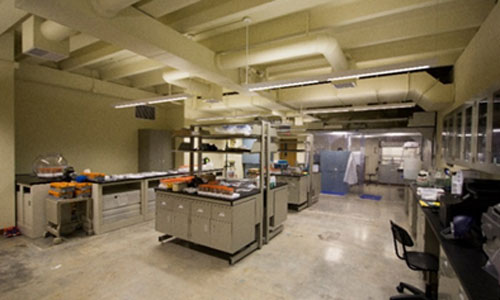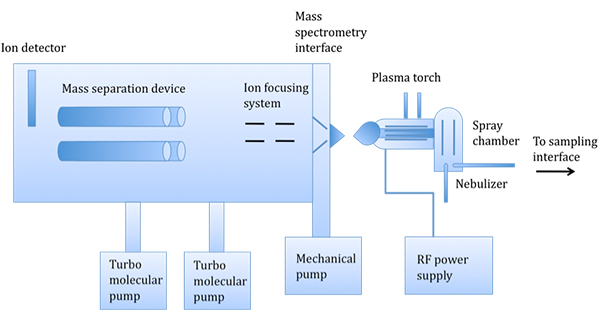ICP-MS Lab
About our ICP-MS lab
The BHSU ICP-MS lab is located in the Jonas Science Building on the BHSU campus. The lab houses a class 10,000 cleanrooms and an Agilent 7900 ICP-MS with SPS 4 Autosampler. In addition to liquid samples, the BHSU ICP-MS is also able to handle solid samples with its ESI NWR 213 laser ablation sample introduction system.
Please contact Brianna Mount (Brianna.Mount@BHSU.edu, (605)642-6094) with any questions related to the ICP-MS or any analysis requests.
About ICP-MS
Inductively Coupled Plasma Mass Spectrometry (ICP-MS) is a technique which allows users to obtain sensitive measurements of concentrations of a range of elements down to the sub parts-per-trillion (ppt) level. With varying applications in diverse fields, this fast, multi-element technique has become an indispensable tool in ultra-trace elemental analysis [Reference 1, Reference 2].
First commercialized in the early 1980’s, the ICP-MS technique has grown rapidly in the subsequent decades [Reference 1, Reference 3]. Its sensitivity to elements from the sub-ppt to ppm range make it the ideal instrument for many applications.
In the standard ICP-MS technique, liquid samples are pumped into a nebulizer where it is mixed with argon gas to form a fine aerosol and sent into the plasma torch. The molecules of the aerosol are broken into ions by the plasma and sent through the mass spectrometry interface consisting of sampling and skimmer cones and into an ion focusing system which directs the ions into the mass separation device and finally onto the detector [Reference 1].
 |
 |

Sample schematic of an ICP-MS instrument
The particular ICP-MS mass separation technique in the Agilent 7900 utilizes a quadrupole, which is the technology with which most ICP-MS instruments operate. An auto-sampler is included for fast, automated data acquisition. In addition to the standard liquid sample introduction system, the ICP-MS facility is also be equipped with a removable laser ablation sample introduction system.
The laser ablation add-on has the ability to analyze solid materials without the need for acid digestion. This is of use in samples which are not easily dissolved. It is also able to spatially resolve analytes on a sample. Laser ablation has the advantage of being able to pinpoint an area on a sample to analyze and be fairly non-destructive due to its small spot size ~4-200 μm. However, with the addition of laser ablation comes a reduction in sensitivity. Laser ablation systems are only sensitive down to the ppb level. The laser ablation add-on is removable in about 30 minutes. This removable sample introduction system enables the ICP-MS at BHSU to flexibly analyze more samples in diverse applications.
Previous Projects
Geology/Environmental Applications
Uranium and Thorium Levels in Geological Samples
Uranium mining is widespread in western South Dakota and northwestern Nebraska, and the potential environmental disturbance derived from this activity is of serious concern to the Oglala Sioux Tribe of the Pine Ridge Indian Reservation. The BHSU group was approached by faculty and students from the Oglala Lakota College (OLC) to participate in a study to evaluate the background levels of U and Th in nine geological samples. The leachable and bioavailable fractions of U and Th were determined in the samples using the BHSU ICP-MS. The found levels in the leachable fraction varied from 0.35 mg kg-1 to 21.4 mg kg-1 U and from 2.0 to 12.6 mg kg-1 Th. The bioavailable fractions were below 3.1 % of the leachable fraction for U and lower than 0.15 % for Th. The OLC group will collect more geological samples from distinct rock outcrops in order to provide the background levels of other potentially toxic elements. Of particular relevance will be the elemental analysis of the collected plant material aiming at finding potential biomonitoring organisms of the studied area.
Antarctic Lichen samples
Antarctica has been recognized as the last pristine environment on Earth. Environmental monitoring assessment programs are active in several Antarctic scientific stations and the most frequently selected samples are soils, sediments, mosses and lichens. Lichens are especially interesting as they enjoy longevity, immobility, and a perennial nature. Another important feature of these sentinel organisms is their well-known capacity of absorbing contaminants from the atmosphere. Airborne pollutants, such as toxic metals, can be directly absorbed by lichen anatomical structures, and have been used for tracking atmospheric pollution over the time. The toxic elements, notably As, Cd, Cr, Pb, Hg, and Ni are persistent in the environment, and they can induce several drastic disturbances, such as imbalances in the food chain, and the development of adverse effects on the organisms as the inhibition of their growth, metabolism and reproduction. Lichen samples have been collected around four Antarctic stations: Arctowski (Polish), Bellingshausen (Russian), Escudero (Chilean), and Comandante Ferraz (Brazilian). The BHSU ICP-MS group will analyze these samples in the coming year and plans to submit a proposal to study lichens in other areas of Antarctica as well.
Physics
Silicon and Sapphire for DARKSIDE
The BHSU ICP-MS group was requested to perform their first low background analysis of a silicon substrate by the DARKSIDE direct matter detector group. Dr. Guerra designed a sample preparation procedure and was able to establish limits for uranium and thorium in the silicon. DARKSIDE has also requested the group analyze sapphire samples with their laser ablation sample introduction system and ICP-MS.
Germanium Analysis
The BHSU group has received germanium samples from the University of South Dakota to analyze. Growing detector-grade germanium crystals requires numerous steps to convert bulk germanium into ultra-pure material used in detectors of rare event experiments. The characterization of materials used in crystal growth is crucial to the crystal growth process, both before and after the crystal has been formed.
If the impurity concentration is too low, it could result in a highly, non-uniform electric field. Conversely, if it is too high, it could result in excessively high depletion voltage and risk a breakdown. The BHSU ICP-MS group will analyze the germanium samples for their B, Al and P content in the coming months to enable USD to better understand their crystal growing process.
Chemistry
ICP-MS Study of Environmental Toxicity of Nanomaterials used in Renewable Energy Generation
Optimization procedures were performed to study nanomaterial degradation in different media. Initial work has focused on characterization of the synthesized nanomaterials. Two undergraduate students, Amber Borkovec and Rachel Stevens spent this summer synthesizing nanomaterials for digestion. The digestion procedure initially showed inconsistent recoveries, which is understandable with the complex chemistry surrounding the nanomaterial. Both students received introductory training and sample preparation training from Dr. Asunskis and Dr. Guerra. This project has been funded in part for the upcoming year through NIH to analyze the material toxicity and the effects on cellular growth. The ICP-MS will continue to be a focal point of this project to analyze the leachable species from the material in media. The bioaccumulation of elements in the cell will also be studied in this upcoming year using the ICP-MS.
Chemical Characterization of Underground Water at Sanford Lab
In the labyrinth of tunnels that comprise the Sanford Lab, there are numerous water microenvironments that are hypothesized to contain unique microbial communities of potential interest to microbiologists. The objective of this study was to characterize water chemistry at distinct and previously unsampled locations, with particular emphasis on those areas undergoing microbial study. Test sites were located at the 4100’ level and 4850’ level of the Sanford Lab. Filtered and unfiltered samples were taken above-ground and analyzed using the BHSU ICP-MS. This study found interesting differences in water composition between levels of the Sanford Lab and more research is ongoing.
Biology
Otolith and Water Chemistry Studies with McNenny State Fish Hatchery
McNenny State Fish Hatchery provides trout and salmon for stocking in the Black Hills, Missouri River Reservoirs and Eastern South Dakota lakes and streams. McNenny is somewhat unique in that the hatchery has a history and culture of research. The BHSU ICP-MS group was approached by the hatchery to provide laser ablation ICP-MS analysis of otoliths as well as analysis of water. The BHSU ICP-MS group has toured the hatchery and discussion are ongoing to determine possible research paths.
Take The Next Step



